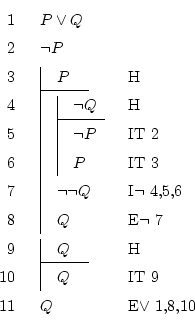Next: 5.13 I had this Up: 5 Explained exercises Previous: 5.11 This one seems Contents
Another which seems easy:
![]() . Let's see:
. Let's see:

It's very easy to understand by anyone: it holds ![]() , but
, but ![]() is false, so the truth is
is false, so the truth is ![]() .
.
It can be done in several ways, but at some time you will have to
use disjunction elimination to do something with the ![]() .
We're going to prove that both
.
We're going to prove that both ![]() and
and ![]() lead to the same place,
which will be our target formula
lead to the same place,
which will be our target formula ![]() (since it's possible, let's
go directly for
(since it's possible, let's
go directly for ![]() ).
).
We open subdemonstration supposing that ![]() , and we must see that
, and we must see that
![]() . It isn't too hard since we have
. It isn't too hard since we have ![]() on line 2; this helps
contradicting anything we want. Since what we're searching is
on line 2; this helps
contradicting anything we want. Since what we're searching is ![]() ,
we suppose
,
we suppose ![]() and by reduction to the absurd we obtain
and by reduction to the absurd we obtain
![]() , which is
, which is ![]() .
.
The other path, when we suppose ![]() true, leads us directly to
true, leads us directly to ![]() .
.
In conclusion, both paths go to ![]() and by disjunction elimination
we get the proof that
and by disjunction elimination
we get the proof that ![]() is always certain.
is always certain.
Daniel Clemente Laboreo 2005-05-17